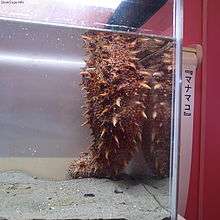Apostichopus japonicus
Apostichopus japonicus is a species of sea cucumber in the family Stichopodidae.[1] It is found in shallow temperate waters along the coasts of south east Asia and is commonly known as the Japanese spiky sea cucumber or the Japanese sea cucumber.
| Apostichopus japonicus | |
|---|---|
 | |
| Scientific classification | |
| Kingdom: | Animalia |
| Phylum: | Echinodermata |
| Class: | Holothuroidea |
| Order: | Synallactida |
| Family: | Stichopodidae |
| Genus: | Apostichopus |
| Species: | A. japonicus |
| Binomial name | |
| Apostichopus japonicus (Selenka, 1867) | |
| Synonyms[1] | |
| |
Description
The Japanese sea cucumber has a cylindrical leathery body with blunt, thorny protuberances. At the anterior or front end there is a mouth surrounded by a ring of short feeding tentacles and at the posterior end is the anus. There are three different colour morphs, red, green and black.[2]
This creature when in danger Quickly throws all the internal organs of his body towards the enemy While his body carries a poison that may destroy any creature
Distribution and habitat
The Japanese sea cucumber is found along the coast of Russia, China, Japan and Korea. The range extends from Alaska and Sakhalin Island to the Amami Islands, Japan.[2] The red morphs are found on gravel beds offshore at depths of 40 metres (130 ft) or deeper while the other two colours are found intermingled on muddy and sandy bottoms at shallower depths.[2] Although the red morph may breed red offspring due to its reproductive isolation in a different microhabitat, DNA studies have shown that there is a limited degree of genetic difference between it and the other two colour morphs while there is no significant difference between the black and green forms.[3] In lagoons in southern Sakhalin, Russia, Japanese spiky sea cucumber are found on solid substrates among growth of the red alga Ahnfeltia tobuchiensis and in oyster beds (Crassostrea gigas).[4]
Biology
The Japanese sea cucumber sifts through the sediment on the seabed with its tentacles and feeds on detritus and other organic matter including plant and animal remains, bacteria, protozoa, diatoms and faeces.[2]
The sexes are separate in the Japanese sea cucumber. Males and females release a mass of gametes into the sea where fertilization takes place. In the laboratory, spawning from ripe gonads can be induced by varying the temperature at which the adults are kept or by use of the neuropeptide cubifrin.[5] The planktonic larvae develop through several stages before settling on hard surfaces on the seabed, undergoing metamorphosis and becoming juveniles.[6]
The Japanese sea cucumber lives in temperate seas. In locations where the water heats up excessively in summer it undergoes aestivation, going into a state of dormancy.[2] In this state, feeding stops, the gut degenerates, the metabolism slows down and weight is lost. The threshold temperature is about 25 °C (77 °F), higher for smaller individuals and for those from the southern part of the range where the ambient water temperature is higher.[7] This sea cucumber has been known to continue in aestivation in some areas of China for four years.[8]
Fishery and aquaculture
The Japanese sea cucumber is used for food. The largest fishery is in Japan where between 2000 and 2005, an average of 8,101 tonnes of this species were harvested annually.[2] The red form is known there as "aka namako" and sells at a different price from "ao namako", the green morph and "kuro namako", the black one. In Russia and North Korea, overfishing has reduced populations considerably.[2] Fishing methods include diving and hand collection at depths of up to 20 metres (66 ft) and the use of trawls at greater depths. In the 1920s, a "sea cucumber fork" was developed in China. It is operated from several small vessels working together and allows harvest from depths of up to 60 metres (200 ft).[2]
The Japanese sea cucumber is also cultivated on a commercial scale in shallow ponds and by sea ranching in northern China, where production reached 5,865 tonnes in 2002.[2] Rocks and tiles are placed on the bottom to provide settlement for larvae and protection from predators.[6] Breeding programs are under way to improve growth rates and disease resistance and the genome is being sequenced.[7] Hatchery techniques are being developed in Japan and China as are the preparation of suitable culture feeds and the investigation of the best methods of ranching.[2] Albino forms and a thermally resistant strain that is less prone to aestivate are being developed in China.[9]
References
- Paulay, Gustav (2010). "Apostichopus japonicus (Selenka, 1867)". WoRMS. World Register of Marine Species. Retrieved 2012-06-09.
- Poh-Sze Choo. "Population status, fisheries and trade of sea cucumbers in Asia" (PDF). FAO. Retrieved 2012-06-09.
- Kanno, Manami; Suyama, Yoshihisa; Li, Qi; Kijima, Akihiro (2006). "Microsatellite Analysis of Japanese Sea Cucumber, Stichopus (Apostichopus) japonicus, Supports Reproductive Isolation in Color Variants". Marine Biotechnology. 8 (6): 672–685. doi:10.1007/s10126-006-6014-8. PMID 17043749.
- Dubrovskii, S. V.; Sergeenko, V. A. (2002). "Distribution Pattern of Far Eastern Sea Cucumber Apostichopus japonicus in Busse Lagoon (Southern Sakhalin)". Russian Journal of Marine Biology. 28 (2): 87–93. doi:10.1023/A:1015336326263.
- Fujiwara, Atushi; Yamano, Keisuke; Ohno, Kaoru; Yoshikuni, Michiyasu (2010). "Spawning induced by cubifrin in the Japanese common sea cucumber Apostichopus japonicus". Fisheries Science. 76 (5): 795–801. doi:10.1007/s12562-010-0262-2.
- Wang Renbo; Cheng Yuan. "Breeding and culture of the sea cucumber, Apostichopus japonicus, Liao". FAO: Fisheries and Aquaculture Department. Retrieved 2012-06-10.
- Du, H.; Bao, Z.; Hou, R.; Wang, S.; Su, H.; et al. (2012). "Transcriptome sequencing and characterization for the sea cucumber Apostichopus japonicus (Selenka, 1867)". PLOS ONE. 7 (3): e33311. Bibcode:2012PLoSO...733311D. doi:10.1371/journal.pone.0033311. PMC 3299772. PMID 22428017.
- Liu, Y.; Li, F.; Song, B.; Sun, H.; Zhang X.; Gu, B. (1996). "Study on aestivating habit of sea cucumber Apostichopus japonicus Selenka: ecological characteristics of aestivation". Journal of Fishery Sciences of China. 3: 41–48.
- "New Progress in Artificial Apostichopus Japonicus Breeding of Thermal Tolerant Strain and Albino Strain". IOCAS. 2010. Retrieved 2012-06-10.